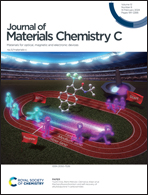Unlocking the resistive switching in Acacia Senegal-based electrolyte for neuromorphic computation†
Abstract
The conduction of ionic species through solid-state memristive devices exhibited markedly lower mobility than that of ions (Na+, K+, and Ca2+) in the human brain, presenting a major bottleneck of implementation of these devices for neuromorphic applications. In an attempt to resolve this issue and compete with demands in soft electronic technologies, ionic electrolytes are promising candidates as active materials. Herein, we report a new approach for implementing the rheological properties of Acacia Senegal with sodium chloride (AS@NaCl) electrolyte to obtain the resistive switching property. The device exhibits resistive switching, with the SET process with energy condumption of 0.16 mJ, and ∼5.46 μJ with 1.2 cm and 0.2 mm channel diameter, respectively. Impedance spectroscopy was performed to investigate the role of the rheological properties of the medium and the medium–electrode interface for resistive switching. Furthermore, a theoretical model was adopted for quantitative analysis. To evaluate the potential of the device for neuromorphic tasks and prove its resemblance with the synapse governing neuronal dynamics, all four spike time dependent plasticity (STDP) (symmetric (Hebbian/Anti-Hebbian) and asymmetric (Hebbian/Anti-Hebbian)) pattern in addition to other preliminary synaptic characteristics are presented. The findings reveal the potential of the AS@NaCl electrolyte for low-cost and easy processable technology for memristive applications.



 Please wait while we load your content...
Please wait while we load your content...